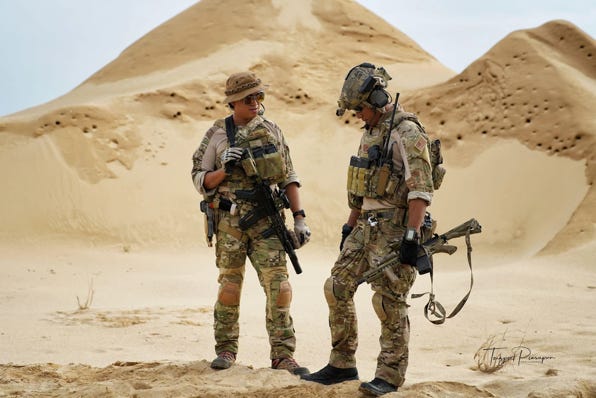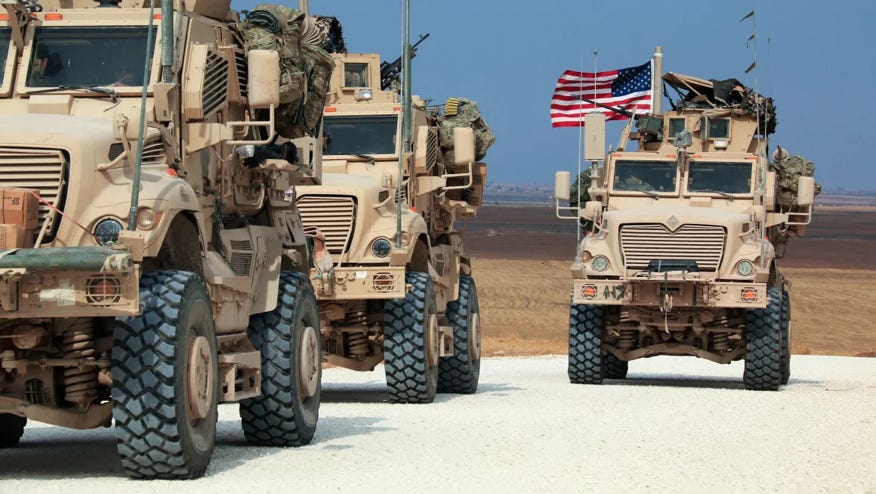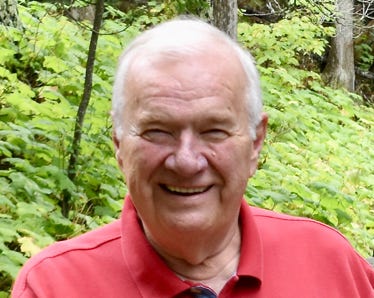DUTY, HONOR, COURAGE, RESILIANCE
Talking Proud: Service & Sacrifice
Syria: A fractured state
Venture into the unfamiliar
AP Photo/Baderkhan Ahmad
US troops in Syria: The headcount?
This section addresses the number of US ground troops in Syria. I divide them into two force applications:
- Secure Syrian oilfields
- Block the road and routes to Israel and Lebanon
The following two sections address both missions. First, let’s examine how this started.
President Obama sent US ground forces to Syria, starting with “no more than 50” in 2015 and then sending another 250 in 2016.
In a June 2016 letter to the House of Representatives and Senate, President Obama said, “The Force Management Level for U.S. Armed Forces in Syria is 300.” I believe he counted only the 50 and 250 he sent to northeastern Syria, not including the 200 or so at al-Tanf base in far southern Syria. At this point, I have concluded that there were 500 in Syria.
In 2017, President Trump deployed another 400 troops to Syria, which included Marines. The Congressional Progressive Caucus objected, to no avail.
These 400 additions brought the total number of US ground forces in Syria to 900, a figure widely used by the Trump and Biden administrations until December 2024. I believe 200 were at al-Tanf in the south, and the other 700 were committed to securing the oil fields in northeastern Syria from IS and preventing its resurgence.
Number crunching to obtain a headcount for deployed US forces is always challenging for politicians and the Pentagon. They have a history of hiding and disguising ground force deployments abroad.
In December 2018, the Guardian of London reported that the US had 2,000 troops in Syria, more than the 900 we knew about in 2017. The New York Times and Washington Post also reported the same.
Pentagon spokesman Col. Rob Manning, USA, told reporters in December 2017 that Secretary of Defense James Mattis wanted “to be transparent about how many troops are deployed in harm’s way.” Thus, the newspapers were correct.
The Times added this, which I guess attempts to explain why the number of 2,000 was higher than previously known,
“Beyond the contingent of Special Operations forces, the American presence in Syria includes conventional troops tasked with securing rural outposts, engineers for base construction, airmen for flight operations and trainers for the Syrian Democratic Forces, according to defense officials.”
However, in November 2020, Katie Bo Wiliams reported that the number was 900 for Defense One. She reported,
“Anonymous officials put the number (of US troops in Syria) at about 900 today, but the precise figure is classified and remains unknown even, it appears, to members of Trump’s administration keen to end the so-called ‘forever wars.’”
In sum, the number was 2,000 in 2017 and 900 in 2020. It is not clear what happened to the 1,100 delta between 2018 and 2000. President Trump did rock the boat in 2019 by ordering the withdrawal of US ground forces from Syria, so perhaps some were taken out. Or maybe the Pentagon did not include the non-combatants. Or possibly the Pentagon was disguising the numbers. I do not know.
I suspect what James Jeffries told Katie Williams is the most likely story. Jeffries was the United States Special Representative for Syria Engagement. She quoted him as saying,
“We were always playing shell games to not make clear to our leadership how many troops we had there (in Syria) … What Syria withdrawal? There was never a Syria withdrawal.”
Britain’s Chatham House commented,
“Regarding personnel, it is difficult to determine the number of troops, Department of Defense (DOD) civilians, Pentagon contractors, and military capabilities located within the Middle East at any given time. Some personnel are deployed on temporary duty and therefore not included in official estimates.”
Department of Defense spokespeople used the 900 figure for close to four years.
Then, the other shoe dropped. In December 2024, Major General Patrick Ryder, USAF, the Pentagon spokesman, revealed the US had 2,000 ground troops in Syria, eleven hundred more than he had been briefing for a long time. Ryder’s revelation was startling. Even more surprising was Ryder’s explanation,
“I learned today that, in fact, there are approximately 2,000 U.S. troops in Syria. These additional forces are considered temporary rotational forces that deploy to meet shifting mission deployments.
“I got word of it recently as our team was looking at this ... given the significant situation in Syria.
"I asked for more information on this, recognizing that if the numbers are not what we brief, let's find out what the actual numbers are and go from there.”
He added that he "got the numbers today (December 19, 2019).”
He inferred that Secretary of Defense Austin knew the correct number but did not reveal it to Ryder, who continued using the 900 number.
I can only speculate about what prompted the increase. A CENTCOM statement in June 2024 may provide some insight,
“From January to June 2024, ISIS has claimed 153 attacks in Iraq and Syria. At this rate, ISIS is on pace to more than double the total number of attacks they claimed in 2023. The increase in attacks indicates ISIS is attempting to reconstitute following several years of decreased capability.
“The continued pursuit of the approximately 2,500 ISIS fighters at large across Iraq and Syria is a critical component to the enduring defeat of ISIS. Equally important are the ongoing international efforts to repatriate more than 9,000 ISIS detainees in detention facilities in Syria, and the repatriation, rehabilitation, and reintegration of more than 43,000 individuals and families from the Al Hol and Al Roj camps.”
CENTCOM acknowledged that IS has not been defeated but degraded and is perhaps even reconstituting.
The Middle East Institute noted in July 2024,
“(The year) 2024 has seen a dramatic surge in ISIS attacks on Syrian soil … in Syria … ISIS is reawakening” and asserted that the culprit was Iran. It continued,
“The (ISIS) group has been slowly and methodically rebuilding its capabilities since 2020, especially in the regime-held central badiya (desert). It has been in this vast expanse of minimally populated territory that ISIS has slowly rebuilt itself in recent years, taking advantage of a regime that lacks the capability to tackle a dispersed insurgency and whose track record of caring about ISIS is poor.”
I do not know how these 2,000 troops are distributed, and I’m not even sure 2,000 is correct. In the following two sections, I will try to explain where they might be on any given day.
And then there is Kenneth Rosen, reporting for the Alicia Patterson Foundation in October 2023, who said,
“Many of the troops were … chartered between northern Iraq and Syria for daily deployments, returning to a base in Iraqi Kurdistan at night, offering officials the opportunity to claim there were fewer troops inside Syria than there actually were.”
As I said at the outset, calculating the headcount of deployed US forces is always challenging.
Click to zoom graphic-photo



